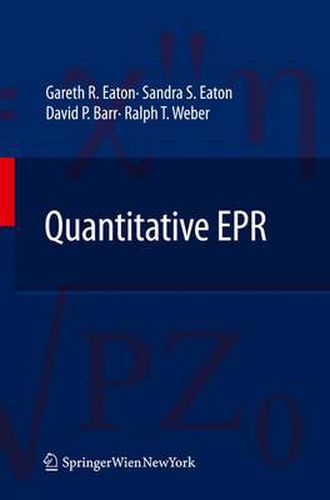Readings Newsletter
Become a Readings Member to make your shopping experience even easier.
Sign in or sign up for free!
You’re not far away from qualifying for FREE standard shipping within Australia
You’ve qualified for FREE standard shipping within Australia
The cart is loading…






This title is printed to order. This book may have been self-published. If so, we cannot guarantee the quality of the content. In the main most books will have gone through the editing process however some may not. We therefore suggest that you be aware of this before ordering this book. If in doubt check either the author or publisher’s details as we are unable to accept any returns unless they are faulty. Please contact us if you have any questions.
There is a growing need in both industrial and academic research to obtain accurate quantitative results from continuous wave (CW) electron paramagnetic resonance (EPR) experiments. This book describes various sample-related, instrument-related and software-related aspects of obtaining quantitative results from EPR expe- ments. Some speci?c items to be discussed include: selection of a reference standard, resonator considerations (Q, B ,B ), power saturation, sample position- 1 m ing, and ?nally, the blending of all the factors together to provide a calculation model for obtaining an accurate spin concentration of a sample. This book might, at ?rst glance, appear to be a step back from some of the more advanced pulsed methods discussed in recent EPR texts, but actually quantitative routine CW EPR is a challenging technique, and requires a thorough understa- ing of the spectrometer and the spin system. Quantitation of CW EPR can be subdivided into two main categories: (1) intensity and (2) magnetic ?eld/mic- wave frequency measurement. Intensity is important for spin counting. Both re- tive intensity quantitation of EPR samples and their absolute spin concentration of samples are often of interest. This information is important for kinetics, mechanism elucidation, and commercial applications where EPR serves as a detection system for free radicals produced in an industrial process. It is also important for the study of magnetic properties. Magnetic ?eld/microwave frequency is important for g and nuclear hyper?ne coupling measurements that re?ect the electronic structure of the radicals or metal ions.
$9.00 standard shipping within Australia
FREE standard shipping within Australia for orders over $100.00
Express & International shipping calculated at checkout
This title is printed to order. This book may have been self-published. If so, we cannot guarantee the quality of the content. In the main most books will have gone through the editing process however some may not. We therefore suggest that you be aware of this before ordering this book. If in doubt check either the author or publisher’s details as we are unable to accept any returns unless they are faulty. Please contact us if you have any questions.
There is a growing need in both industrial and academic research to obtain accurate quantitative results from continuous wave (CW) electron paramagnetic resonance (EPR) experiments. This book describes various sample-related, instrument-related and software-related aspects of obtaining quantitative results from EPR expe- ments. Some speci?c items to be discussed include: selection of a reference standard, resonator considerations (Q, B ,B ), power saturation, sample position- 1 m ing, and ?nally, the blending of all the factors together to provide a calculation model for obtaining an accurate spin concentration of a sample. This book might, at ?rst glance, appear to be a step back from some of the more advanced pulsed methods discussed in recent EPR texts, but actually quantitative routine CW EPR is a challenging technique, and requires a thorough understa- ing of the spectrometer and the spin system. Quantitation of CW EPR can be subdivided into two main categories: (1) intensity and (2) magnetic ?eld/mic- wave frequency measurement. Intensity is important for spin counting. Both re- tive intensity quantitation of EPR samples and their absolute spin concentration of samples are often of interest. This information is important for kinetics, mechanism elucidation, and commercial applications where EPR serves as a detection system for free radicals produced in an industrial process. It is also important for the study of magnetic properties. Magnetic ?eld/microwave frequency is important for g and nuclear hyper?ne coupling measurements that re?ect the electronic structure of the radicals or metal ions.